Your Guide to Tasting the Many Species of Pacific Salmon
From dogs to humpies to kings, the author tastes and discusses the five main species of Pacific salmon
Biggest, most succulent and greasiest of the salmon, the Chinook, or king. Photo courtesy of Flickr user Kyle Strickland.
Salmon are one of nature’s miracles, a resource of protein and nitrogen that feeds entire ecosystems, both marine and terrestrial. Far inland, within river basins of the Pacific Northwest, their biomass nourishes the soil, while at sea, nearly every level of predator–from rockfish to halibut to seal to orca–relies at least partially on this abundant source of food. Salmon are also one of the most revered guests in any kitchen. Their bright red meat is so distinct and so delicious that it hardly qualifies merely as seafood but, rather, occupies a princely culinary category of its own. But within the Pacific salmon genus, Oncorhynchus, there are five main species–and they are all very different. Some restaurant menus will specify the species–especially if the fish is Chinook, also called king. Other times, salmon is sold anonymously or under false marketing names–like “silverbrite” for the ill-named chum salmon. Some is, of course, farmed–almost always the Atlantic salmon, Salmo salar–but such cage-raised fish are not a part of this discussion. Here, we catch, taste and discuss the wild Pacific salmon–from the reddest to the biggest to the best.
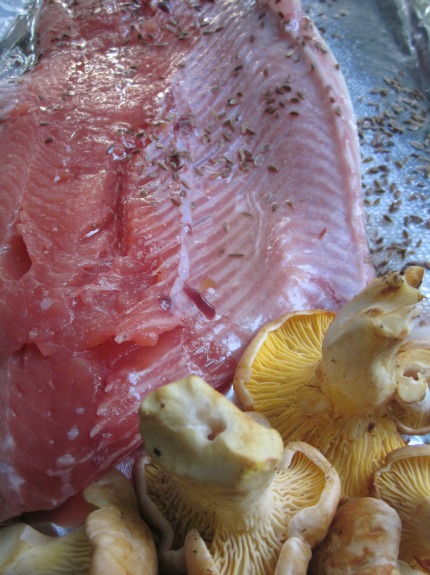
This fillet, to be grilled and served with Alaskan chanterelles, came from a pink salmon, often considered the lousiest tasting of the salmon. Photo by Alastair Bland.
Pink Salmon
What this little fish lacks in size it makes up for in sheer abundance. The pink, or humpie, salmon averages just several pounds in weight–like a large trout–but teems in ocean waters from Oregon to Alaska in the tens of millions. They surge upstream to spawn in astonishing numbers, actually clogging streams at times and making easy pickings for bears, birds, wolves and humans. In places along the Pacific Northwest coast, residents may notice a putrid scent emanating from the woods in mid-summer–literally the smell of a good pink year. Pinks caught in the ocean are the best, as with all salmon. But pinks are not known for their excellence as a table fish. Their meat at its prime–before it begins to deteriorate as the fish swim upstream to spawn and die–is grayish-pink. Indeed, many fishermen believe the pink is good for nothing but canning or halibut bait. Others–like this writer–have found sea-bright pinks to be excellent when wrapped in foil, seasoned and grilled.

Pink salmon are packed like sardines in a small Alaskan stream in which the fish will spawn. Photo courtesy of Flickr user USDA Forest Service Region 10.
Chinook Salmon
Few, if any, fish are more prized by fishermen, whether commercial or recreational, than this giant of the salmon family. The Chinook can grow to the size of a human–more than 100 pounds–and also bears the highest fat content of all the five Pacific salmon species. It is generally considered the most delicious, and its secondary name–the king salmon–is absolutely appropriate in more ways than one. Chinook salmon grow largest in Alaskan waters but also spawn in rivers as far south as the Sacramento and the San Joaquin of California, where they are the only commercially caught salmon. A barbecued steak of king, lightly salted, peppered and drizzled with lemon juice, takes seafood lovers into epicurean heaven. Such a cut provides a cross section of the entire creature–from its crispy-when-grilled skin, to the firm back muscle, to the velvety soft and succulent belly meat–often named as the very best part. Can you believe that some fishermen intentionally cut away the belly flesh to use as crab bait? Chinook salmon have declined in numbers in the southern extent of their range, due mostly to destruction of river habitat, while a poorly managed sport fishing industry for the giants of Alaska’s Kenai River has caused a recent population crash–and an emergency closure on the season.
Chum Salmon
This large and powerful fish is the least known of the Pacific salmon and usually receives the least love–if only because we rarely have a chance to give it any. After they enter freshwater to embark upon their terminal spawning migrations, chums transform dramatically into the ugliest beasts in the Oncorhynchus genus. Their mouths curl into wicked, toothy snarls–especially on males–and their chrome bodies turn brown as large reddish bars and blotches appear along the lateral line. When caught at sea or outside of river mouths, where they often co-mingle with hoards of pink salmon, chums are bright, fresh and–when taken home to eat–perfectly delicious. Some sources suggest cooking chum salmon with a sauce to help moisten the flesh, which is dry compared to that of Chinook or Coho.
But chum, also called dog salmon, was once mainly fed to sled dogs in the far north. It’s rarely found in most American seafood markets, as much of the annual catch goes overseas. Efforts to create culinary demand for chum salmon have struggled and have generally relied on false marketing names, like Keta (the Latin species name of the fish) and Silverbrite (as though all ocean-fresh salmon are not both silver and bright).
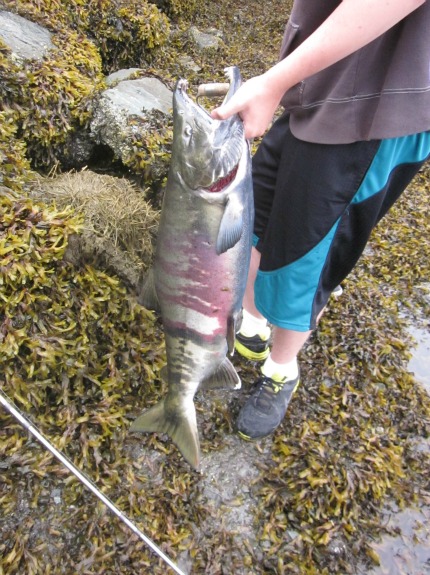
This large chum salmon, caught at the mouth of a small stream in Southeast Alaska, vividly exhibits the spawning colors typical of the species. The flesh of ocean-fresh specimens is delicious but underrated. Photo by Alastair Bland.
Coho Salmon
Esteemed as a fighting game fish as much as it is a food fish, the Coho is unofficially ranked as number-two in the salmon clan. It grows large (up to 30 pounds), aggressively strikes lures and flies and fights wildly when hooked. On the table, it performs just as spectacularly. It has a high oil content (though not as high as the Chinook’s) and its meat is rich, red and delicious. In Alaska, Coho salmon remain abundant. The fish are able to spawn in tiny creeks and once did so in virtually every moving West Coast waterway from Santa Barbara to the Arctic. However, south of Canada, Coho habitat–often streams that have been drained, filled, buried or otherwise fouled by development–has dwindled, and so have the fish. Coho cannot be harvested in much of their sub-Canadian range, and most Coho that arrives on your plate is Alaskan.
Sockeye Salmon
This second-smallest of the Pacific salmon may be tied with the Coho in terms of table quality. Sockeye flesh is brilliantly colored–almost fluorescent orange–and even when canned is sold as gourmet-grade fish. When served fresh, it is top notch–firm, rich and flavorful. In fact, many salmon devotees consider sockeye the absolute best of all the salmon–even better than the king–however one decides to cook it. Sockeye salmon spawn almost exclusively in river systems connected to lakes, but this biological prerequisite hardly detracts from their abundance. They rival pinks in terms of millions and historically swam up the Columbia River in water-clogging millions, their heads turning green and their bodies brilliant red. Those days are gone south of Canada, thanks to hydroelectric dams, logging and other forms of habitat destruction, but in the Fraser, the Kenai, the Yukon and other river systems–many hardly wider than a sidewalk–sockeye salmon still thrive, and those fillets so red they seem like they’d glow in the dark remain perhaps the most abundant form of wild salmon.
/https://tf-cmsv2-smithsonianmag-media.s3.amazonaws.com/accounts/headshot/Off-Road-alastair-bland-240.jpg)
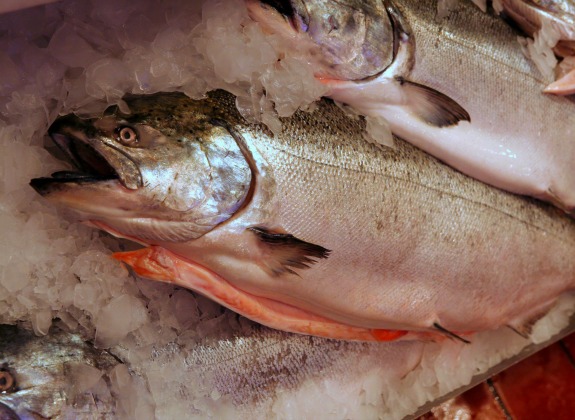
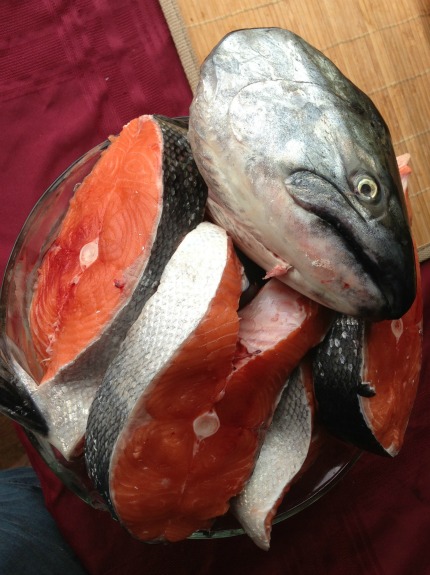
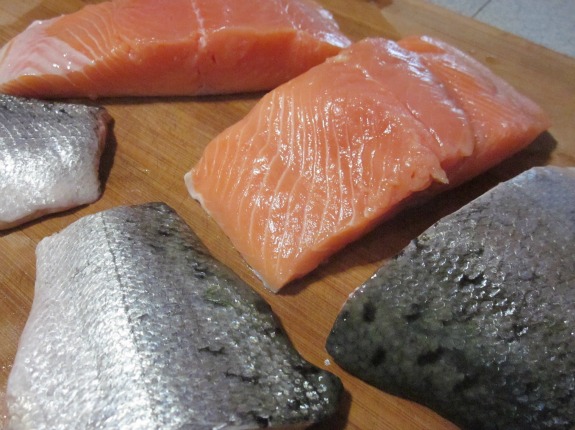
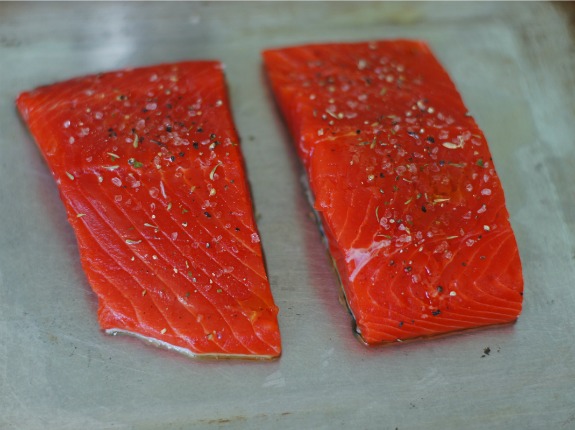
/https://tf-cmsv2-smithsonianmag-media.s3.amazonaws.com/accounts/headshot/Off-Road-alastair-bland-240.jpg)